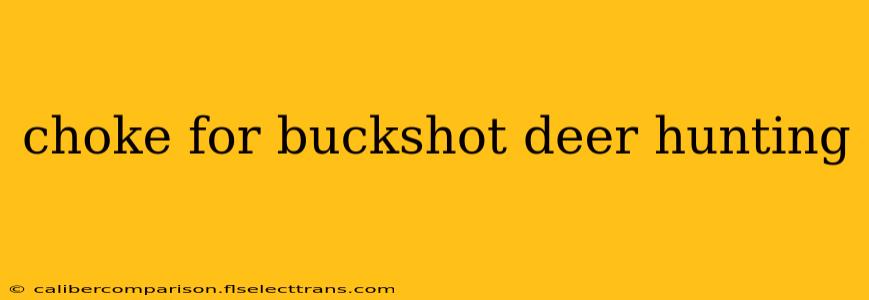Choosing the right choke tube for buckshot deer hunting is crucial for ethical and successful hunting. The wrong choke can lead to inconsistent patterns, reduced effective range, and ultimately, a missed or wounded deer. This guide delves into the intricacies of choke selection for buckshot, helping you make an informed decision to maximize your hunting success and ensure a clean, ethical harvest.
Understanding Buckshot Patterns and Choke Tubes
Buckshot, unlike slugs, consists of multiple pellets, requiring a choke tube that balances pattern density with range. A too-tight choke might create a dense pattern at close range but severely restrict its effective range. Conversely, a too-open choke will spread the shot too widely, reducing the chance of a vital hit at any range.
Key Considerations When Choosing a Choke:
-
Shot Size: The size of your buckshot pellets influences choke choice. Larger buckshot (like 00 or 000) generally benefits from a slightly more open choke than smaller sizes (like #4 buck). Larger pellets have more inertia and are less affected by choke constriction.
-
Shotgun Gauge: Your shotgun's gauge (12 gauge, 20 gauge, etc.) also impacts choke selection. Generally, larger gauge shotguns (like 12 gauge) offer more flexibility in choke choices due to their larger bore diameter.
-
Hunting Distance: Your typical hunting distance is paramount. Close-range shots might tolerate a more open choke, while longer shots demand a tighter choke to maintain pattern density.
-
Your Shotgun: Not all shotguns are created equal. Some might pattern better with certain chokes than others, even within the same gauge and type. Always pattern your shotgun with your chosen buckshot and choke combination before hunting. This is the only way to know for certain how your specific setup performs.
Recommended Choke Options for Buckshot Deer Hunting
While there's no one-size-fits-all answer, certain choke types generally perform well for buckshot deer hunting:
1. Modified Choke: A Versatile Choice
The modified choke offers a good balance between pattern density and range, making it a versatile option for many hunting situations. It provides a decent pattern density for ethical shots at moderate ranges. This is often considered a solid starting point for experimenting with buckshot.
2. Improved Cylinder: Close-Range Performance
For extremely close-range shots, an improved cylinder choke might be appropriate. It produces a wide pattern, increasing the chance of hitting a vital area at very short distances. However, its range is significantly limited, making it unsuitable for longer shots.
3. Full Choke (Use with Caution):
While some hunters might use a full choke with buckshot, it's generally not recommended. It can create an extremely tight pattern at close range, but the effective range is drastically reduced, potentially increasing the risk of wounding a deer without a clean kill. This option should only be considered with extensive patterning and a deep understanding of its limitations.
Patterning Your Shotgun: The Crucial Step
Patterning is absolutely essential. This process involves shooting your shotgun at a target (like a large piece of cardboard) at various distances to visualize the shot pattern produced by your chosen choke and buckshot. This allows you to determine the effective range of your setup and adjust accordingly. Experimentation is key to finding the optimal combination for your specific shotgun and hunting style.
Conclusion: Ethical Hunting Practices First
Ultimately, selecting the right choke for buckshot deer hunting involves finding the balance between pattern density and range that ensures a clean, ethical kill. Remember, responsible hunting practices prioritize a quick, humane harvest. Through careful consideration of these factors and diligent patterning, you can significantly improve your chances of success while upholding ethical hunting standards.

